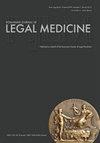Use of Immunohistochemical Examination for Diagnosing and Dating Skin Injuries in Forensic Medicine in Slovakia
IF 0.4
4区 医学
Q4 Medicine
引用次数: 0
Abstract
: In forensic practice, defining the vitality of injuries and the time elapsed from the moment they occurred until the victim’s death is one of the most difficult issues. Mechanical injuries are the most common injuries that a medical examiner encounters in everyday practice. However, the issue of the vitality and age of injuries is important even in the case of other types of violent deaths, e.g., in case of gunshot wounds, burns, hanging, strangulation, throttling, or drowning. Vital changes at the injury site can be assessed based on macroscopic, microscopic, and histochemical findings. Still, in recent years, the development of immunohistochemical techniques has made a significant contribution to more accurate diagnosis and dating of skin injuries. In forensic practice in Slovakia, these methods are not yet commonly performed, although they are an integral and necessary part of the forensic conclusions in foreign countries. The aim of this study was to determine the presence and expression of selected antigens, namely fibronectin and tenascin, in injured skin and adjacent tissues, to distinguish injuries sustained during life from those which aroused after death, to specify the time of harm, and also to determine the possible effects of postmortem changes (autolysis, putrefaction) on the detection and relevance of the results. The acquired findings confirmed the importance of using immunohistochemical methods in dating skin and soft tissue injuries and their application to routine forensic practice in Slovakia, with significant use in expertise activities for law enforcement authorities.免疫组织化学检查在斯洛伐克法医学皮肤损伤诊断和年代测定中的应用
在法医实践中,确定伤害的生命力和从伤害发生到受害者死亡所经过的时间是最困难的问题之一。机械性损伤是法医在日常实践中遇到的最常见的伤害。然而,即使在其他类型的暴力死亡,例如枪伤、烧伤、上吊、勒死、勒死或溺水的情况下,伤口的生命力和年龄问题也很重要。损伤部位的重要变化可以根据宏观、微观和组织化学结果进行评估。尽管如此,近年来,免疫组织化学技术的发展为更准确地诊断和确定皮肤损伤的年代做出了重大贡献。在斯洛伐克的法医实践中,这些方法尚未普遍采用,尽管它们是外国法医结论的一个组成部分和必要部分。本研究的目的是确定受损皮肤和邻近组织中特定抗原(即纤连蛋白和腱素)的存在和表达,以区分生前持续的损伤和死后引起的损伤,确定伤害的时间,并确定死后变化(自溶、腐烂)对结果的检测和相关性的可能影响。获得的研究结果证实了使用免疫组织化学方法确定皮肤和软组织损伤年代的重要性,并将其应用于斯洛伐克的常规法医实践,并在执法当局的专业知识活动中得到重要应用。
本文章由计算机程序翻译,如有差异,请以英文原文为准。
求助全文
约1分钟内获得全文
求助全文
来源期刊
CiteScore
0.50
自引率
25.00%
发文量
0
审稿时长
6-12 weeks
期刊介绍:
The Romanian Journal of Legal Medicine, the official publication of the Romanian Legal Medicine Society, is devoted to the publication of the original investigations, observations, scholarly inquiries and reviews in the various branches of the forensic sciences.
These include forensic pathology and histochemistry, clinical forensic medicine, medical malpractice, traffic medicine, chemistry, biochemistry, thanatochemistry, clinical and forensic toxicology, alcohology, biology (including the identification of hairs and fibres), the physical sciences, firearms, and document examination, physical anthropology, serology, forensic genetics and paternity (with special emphasis on recent advances in DNA technology and PCR), forensic psychiatry and behavioral sciences, forensic odontology, law and ethics, history of forensic sciences. RJLM also includes similar submissions dealing with forensic-oriented aspects of the social science and the area where science and medicine interact with the law.

 求助内容:
求助内容: 应助结果提醒方式:
应助结果提醒方式:


